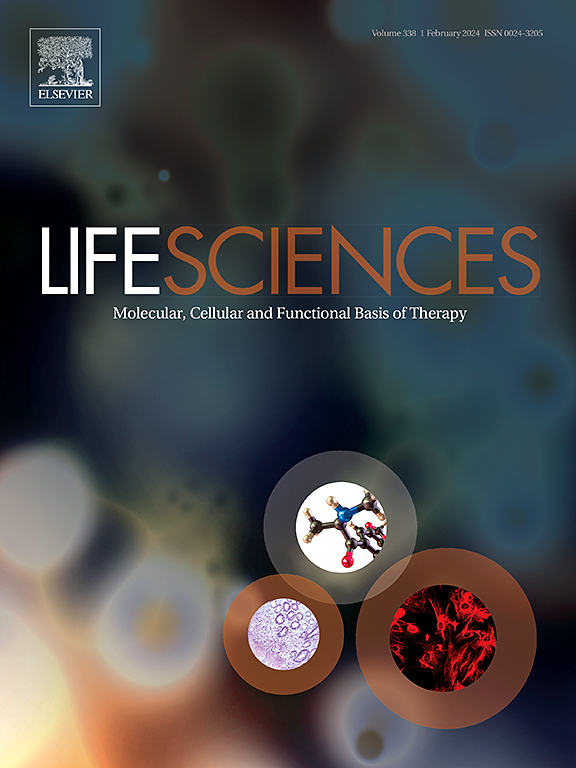微囊藻毒素- lr加重大鼠慢性肾病:肠道微生物组和宿主蛋白质组失调的见解
IF 5.2
2区 医学
Q1 MEDICINE, RESEARCH & EXPERIMENTAL
引用次数: 0
摘要
目的:本研究旨在探讨环境肾毒素微胱氨酸-亮氨酸精氨酸(MC-LR)对慢性肾脏疾病(CKD)肠-肾轴的影响,重点研究肠道微生物组与宿主蛋白质组之间的相互作用。材料与方法:雄性Sprague-Dawley大鼠给予腺嘌呤(200 mg/kg/d)诱导肾损伤,连续10 d,然后给予MC-LR(10 μg/mL/kg,每日1次,隔天1次,连续4 周)。评估肾功能(血尿素氮(BUN)、血清肌酐(SCr)和尿白蛋白/肌酐比(uACR))和肾脏病理(EGTI组织学评分和小红染色)。免疫组化染色检测肾损伤(KIM-1)、纤维化(CTGF)、炎症(HMGB1和CD3)、氧化应激(H2AX)标志物的表达。采用16S rRNA测序分析肠道菌群,LC-MS/MS分析粪便蛋白质组学。主要发现:MC-LR显著加重腺嘌呤诱导的肾损伤,导致肾功能损害(BUN、Cr和uACR水平升高)和肾脏组织病理学恶化(EGTI组织学评分升高和纤维化突出)。MC-LR暴露后,KIM1、HMBG1、CTGF、H2AX和CD3的表达水平升高。值得注意的是,联合用药组促炎细菌科(Enterococcaceae, Enterobacteriaceae)数量增加,而有益菌群(bifidobacteraceae, Muribaculaceae)数量减少。蛋白质组学分析显示炎症标志物(TXNIP, Itgb3bp)上调,与肠球菌科丰度相关。双歧杆菌科与肾损伤标志物呈负相关。意义:我们的研究表明,MC-LR通过破坏肠肾轴而加剧慢性肾脏疾病的进展。我们强调肠道屏障完整性和炎症是关键的治疗靶点,为CKD的治疗提供了新的见解和干预策略,特别是在早期阶段。本文章由计算机程序翻译,如有差异,请以英文原文为准。
Microcystin-LR exacerbates chronic kidney disease in rats: insights into gut microbiome and host proteome dysregulation
Aims
This study aimed to investigate the effects of microcystin-leucine arginine (MC-LR), an environmental nephrotoxin, on the gut-kidney axis in chronic kidney disease (CKD), focusing on interactions between the gut microbiome and host proteome.
Materials and methods
Male Sprague-Dawley rats were administered adenine (200 mg/kg/day) for 10 days to induce kidney injury, followed by MC-LR (10 μg/mL/kg, i.p., every other day for 4 weeks). Renal function (Blood urea nitrogen, BUN; Serum creatinine, SCr and urine albumin to creatinine ratio, uACR) and kidney pathology (EGTI histology scores and picrosirius-red staining) were assessed. Expression of kidney injury (KIM-1), fibrosis (CTGF), inflammation (HMGB1 and CD3), oxidative stress (H2AX) markers were evaluated by immunohistochemical staining. Gut microbiota was analyzed by 16S rRNA sequencing, and fecal proteomics by LC-MS/MS.
Key findings
MC-LR markedly exacerbated adenine-induced kidney injury, leading to impair kidney function (elevated BUN, SCr, and uACR levels) and worsen kidney histopathology (higher EGTI histology scores and prominent fibrosis). Elevated expression levels of KIM1, HMBG1, CTGF, H2AX and CD3 were observed following MC-LR exposure. Notably, pro-inflammatory bacterial families (Enterococcaceae, Enterobacteriaceae) were elevated, while beneficial taxa (Bifidobacteriaceae, Muribaculaceae) decreased in the combination group. Proteomic analysis revealed upregulation of inflammatory markers (TXNIP, Itgb3bp), which correlated with Enterococcaceae abundance. Bifidobacteriaceae negatively correlated with kidney injury markers.
Significance
Our study reveals that MC-LR exacerbates chronic kidney disease progression by disrupting the gut-kidney axis. We highlight gut barrier integrity and inflammation as crucial therapeutic targets, offering novel insights and intervention strategies for CKD management, particularly in beyond early stages.
求助全文
通过发布文献求助,成功后即可免费获取论文全文。
去求助
来源期刊

Life sciences
医学-药学
CiteScore
12.20
自引率
1.60%
发文量
841
审稿时长
6 months
期刊介绍:
Life Sciences is an international journal publishing articles that emphasize the molecular, cellular, and functional basis of therapy. The journal emphasizes the understanding of mechanism that is relevant to all aspects of human disease and translation to patients. All articles are rigorously reviewed.
The Journal favors publication of full-length papers where modern scientific technologies are used to explain molecular, cellular and physiological mechanisms. Articles that merely report observations are rarely accepted. Recommendations from the Declaration of Helsinki or NIH guidelines for care and use of laboratory animals must be adhered to. Articles should be written at a level accessible to readers who are non-specialists in the topic of the article themselves, but who are interested in the research. The Journal welcomes reviews on topics of wide interest to investigators in the life sciences. We particularly encourage submission of brief, focused reviews containing high-quality artwork and require the use of mechanistic summary diagrams.
 求助内容:
求助内容: 应助结果提醒方式:
应助结果提醒方式:


